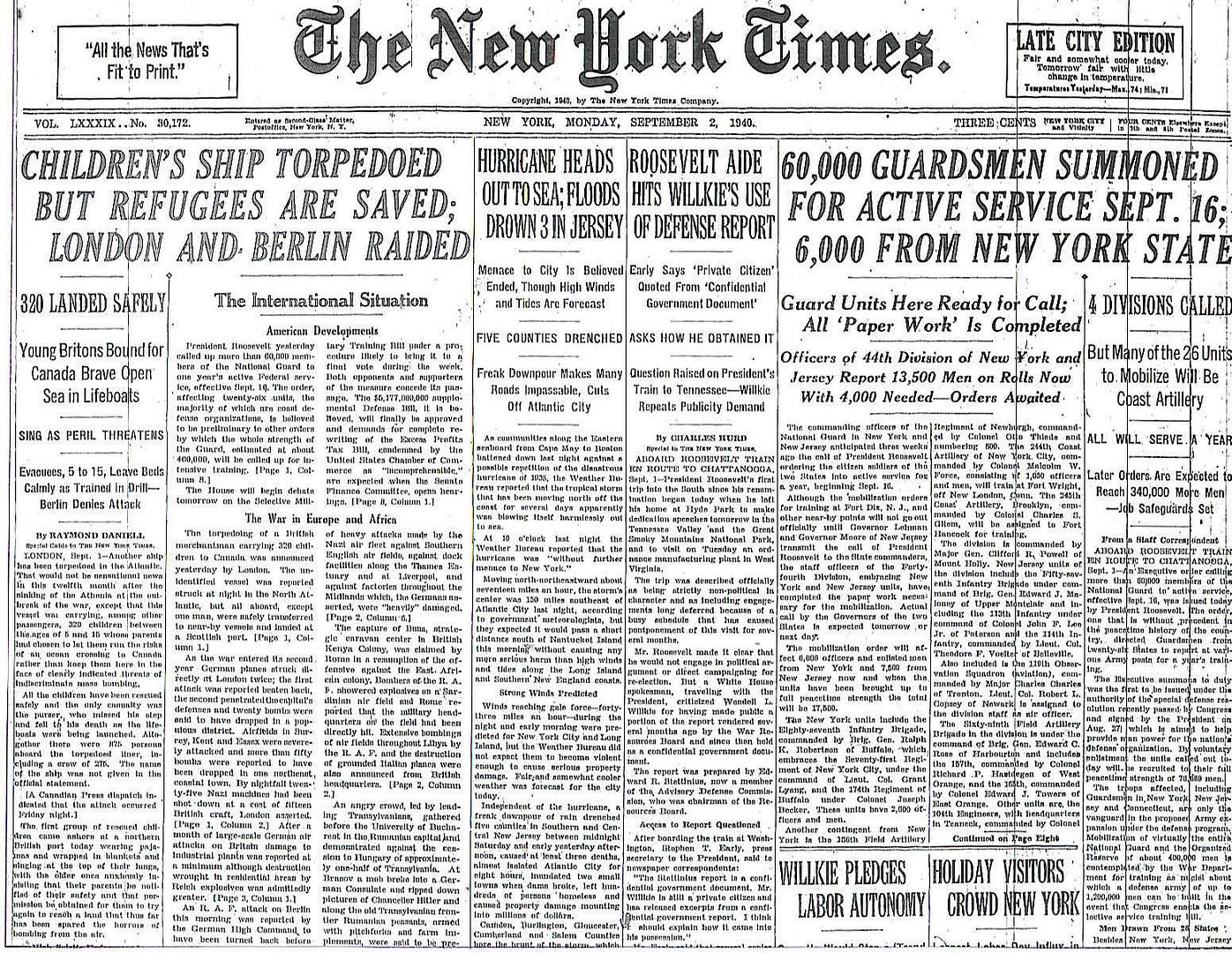
Posted on 09/02/2010 5:35:41 AM PDT by Homer_J_Simpson

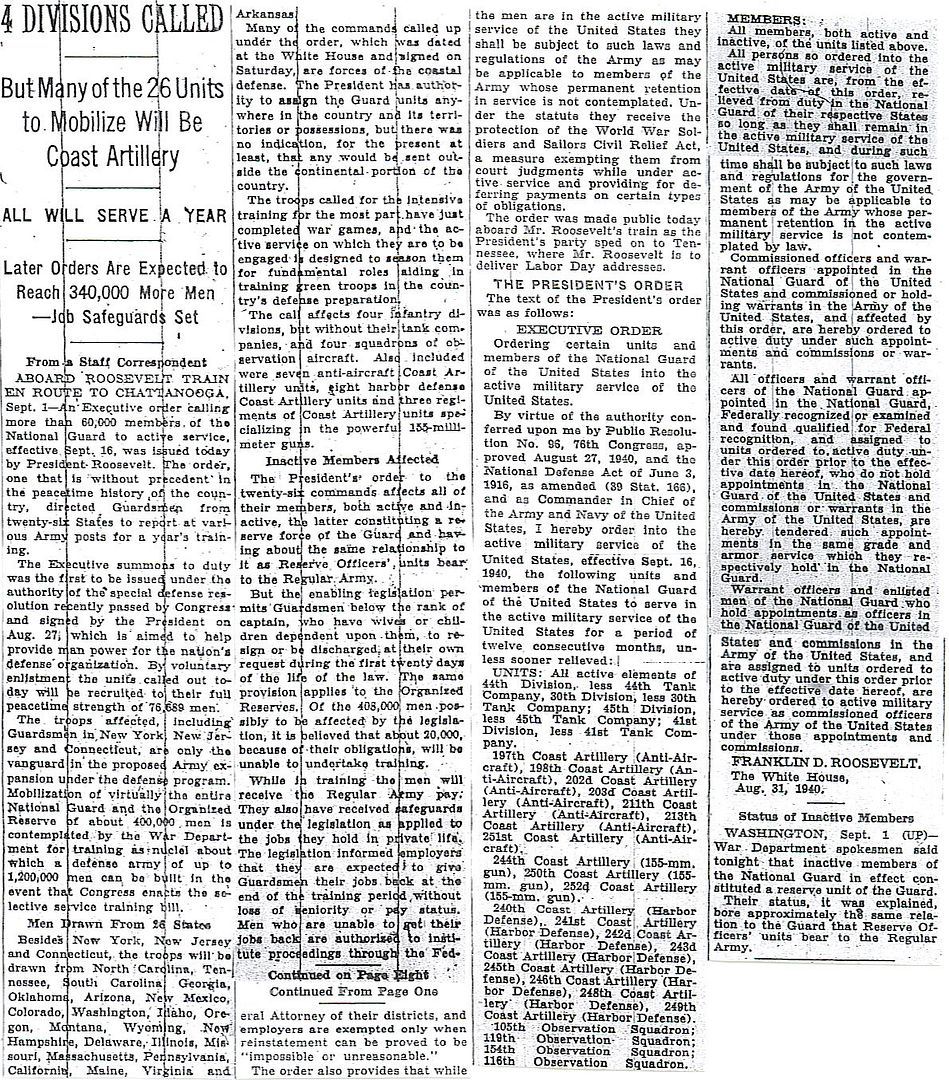
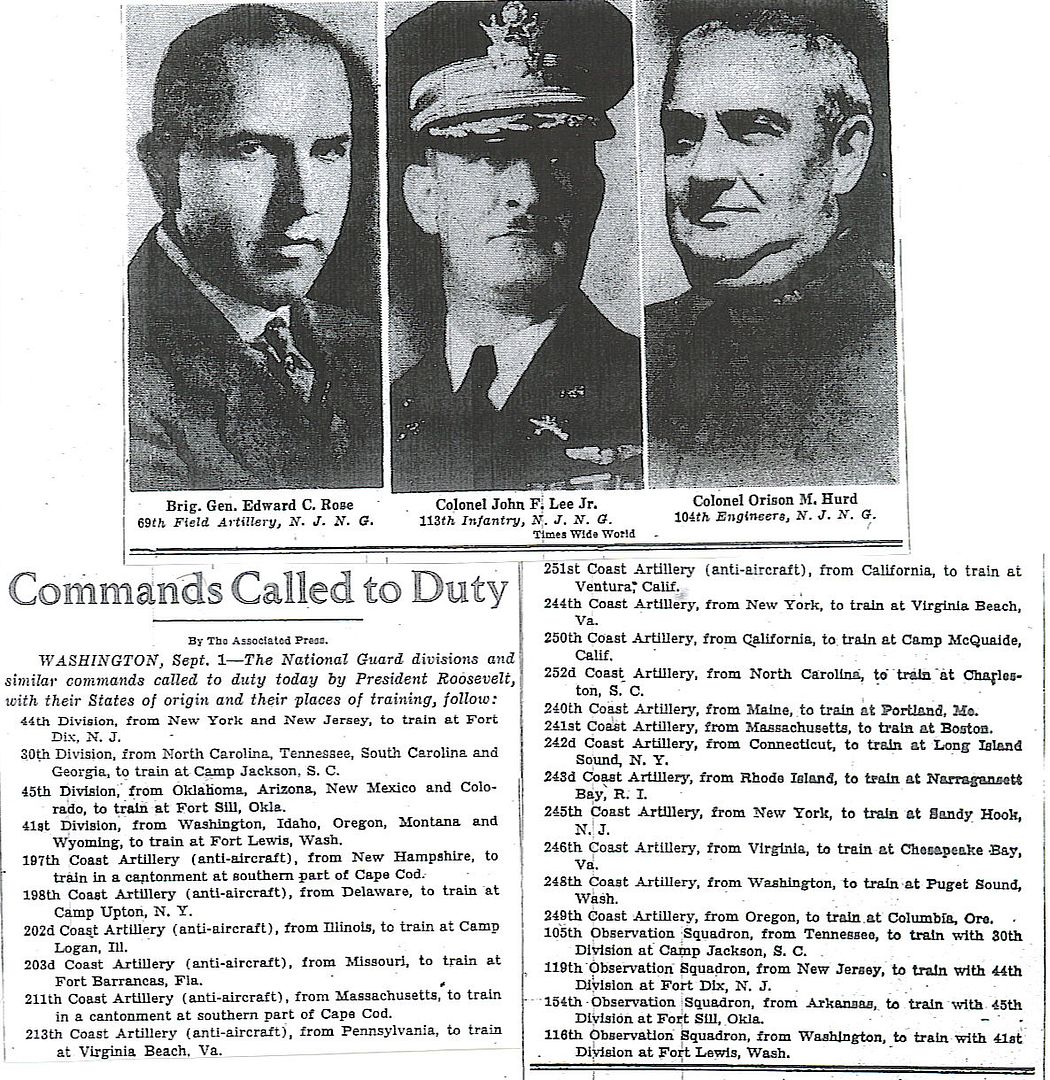
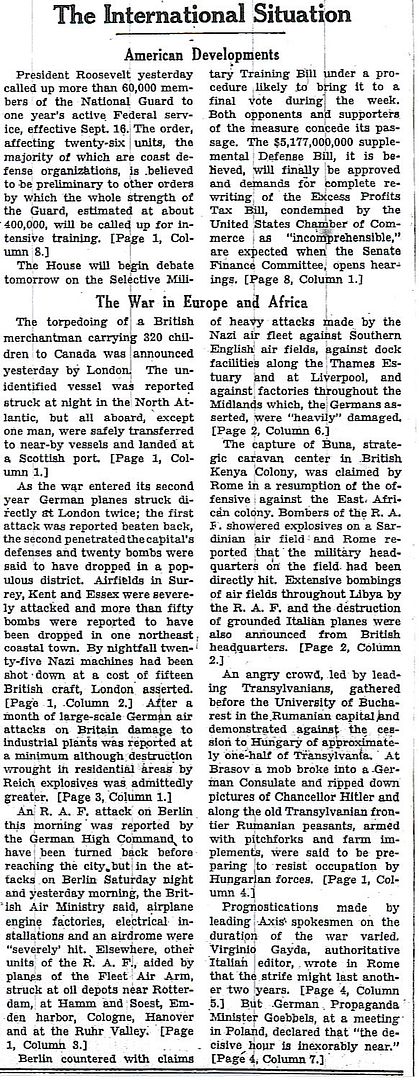
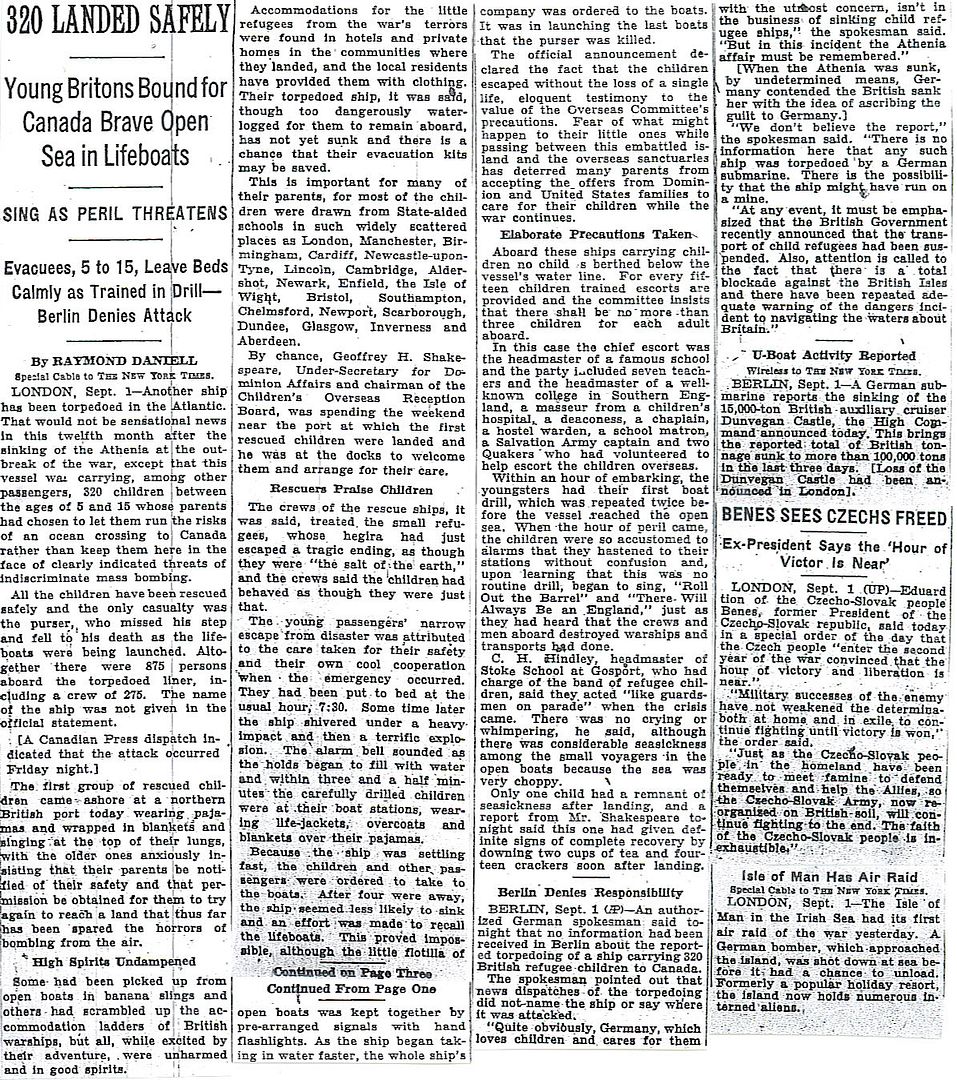
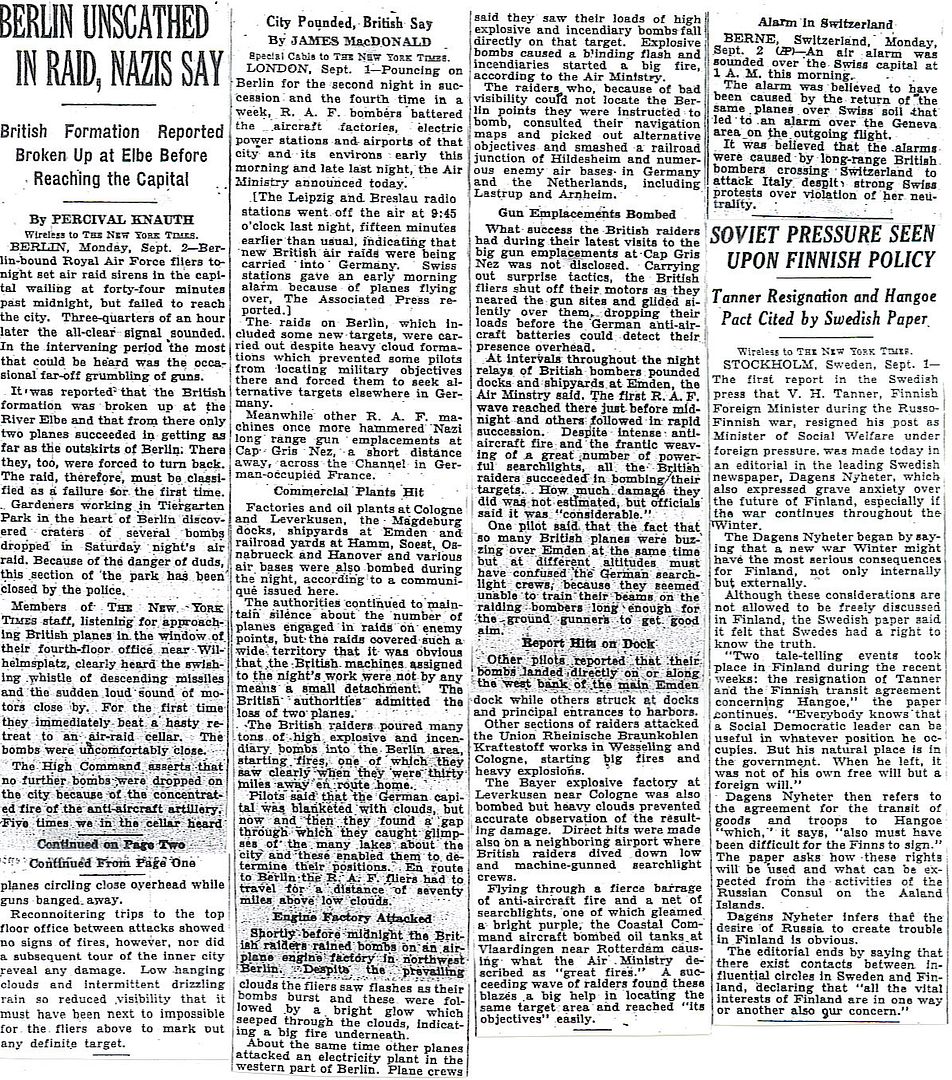
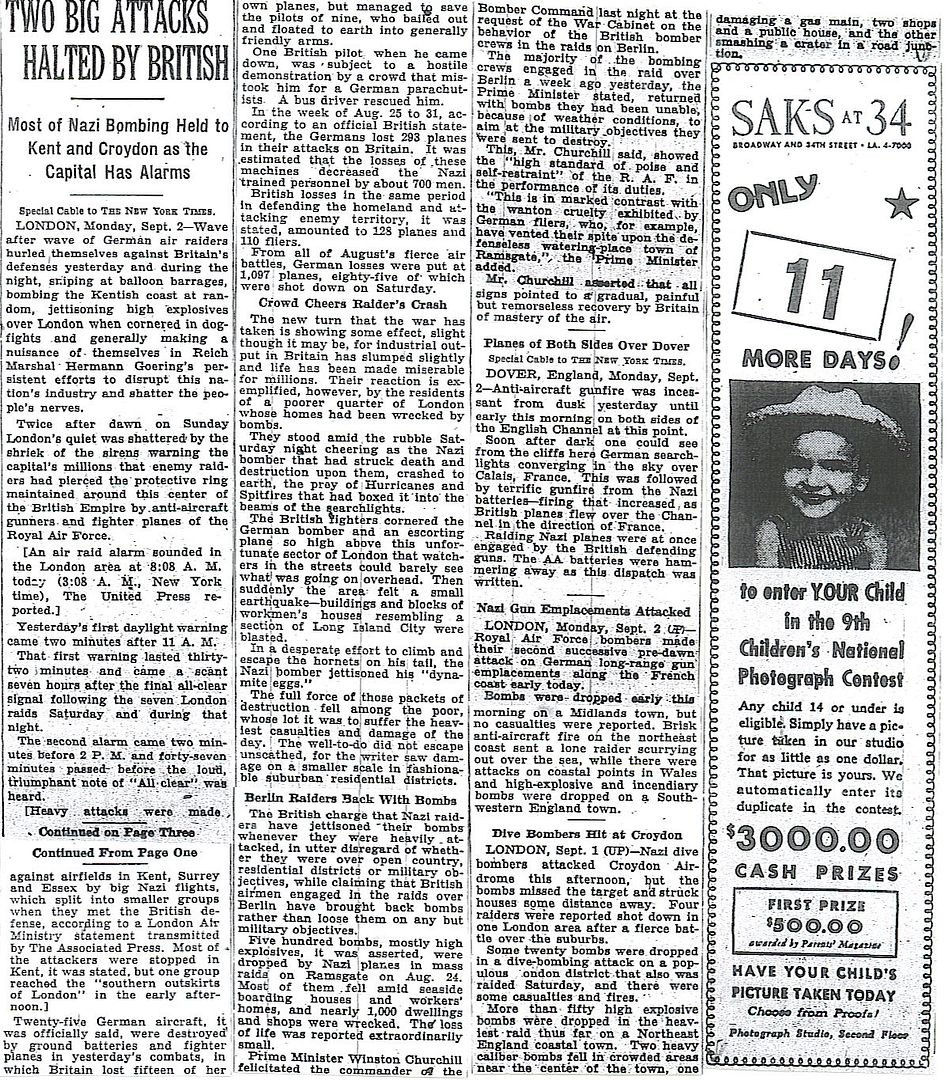
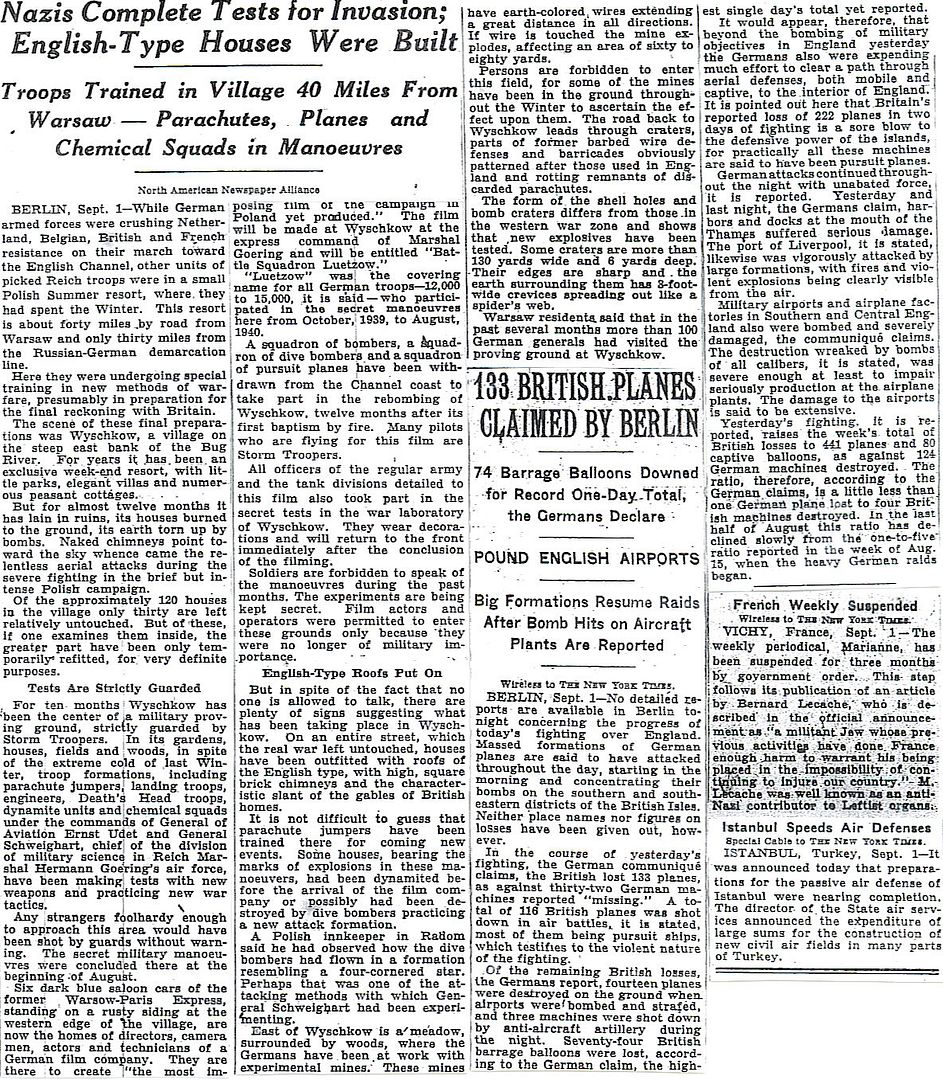
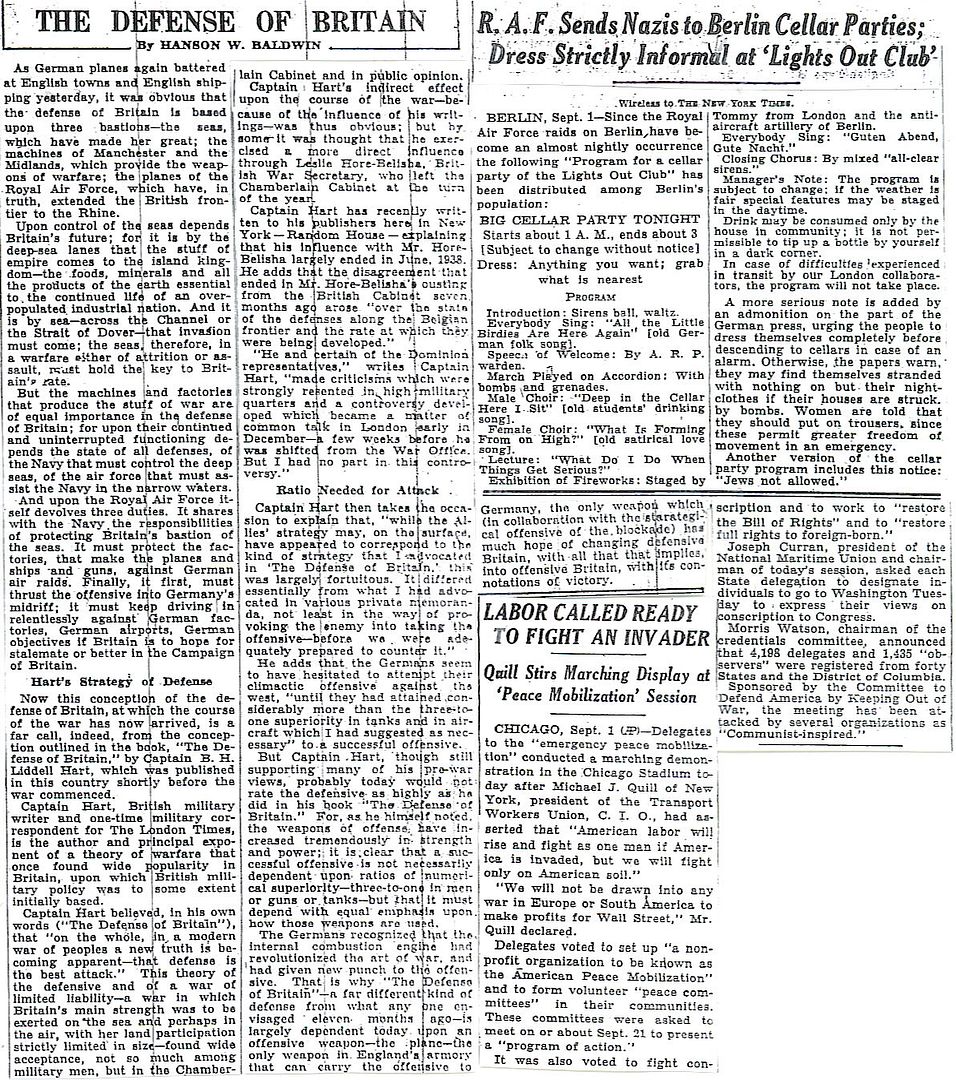
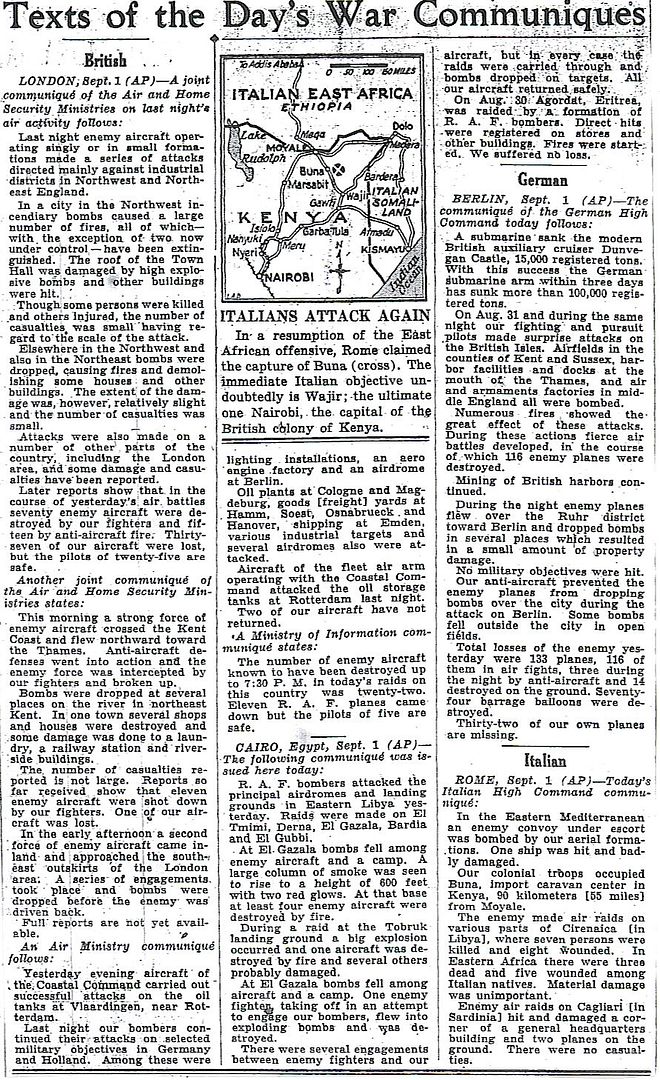
Plus a special guest map from Michael Korda’s, “With Wings Like Eagles,” showing the air defenses of England and Wales, August 1940.
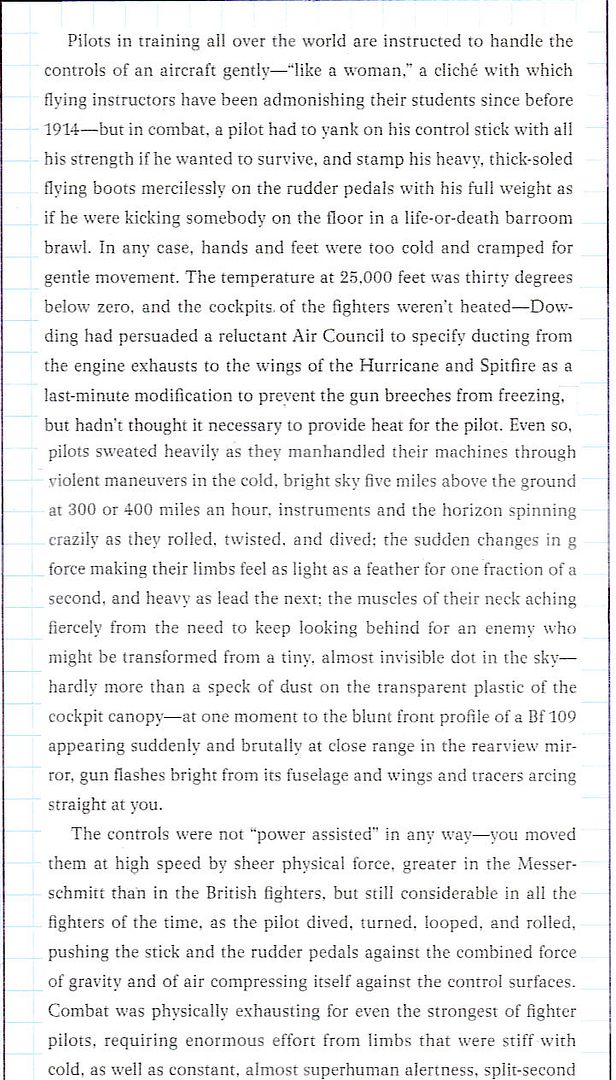
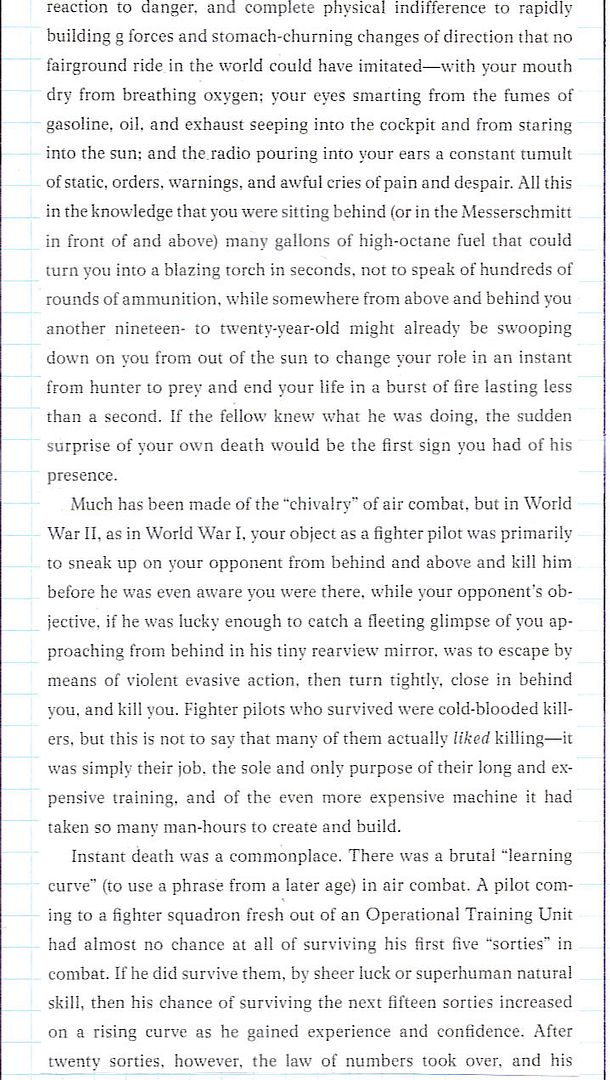
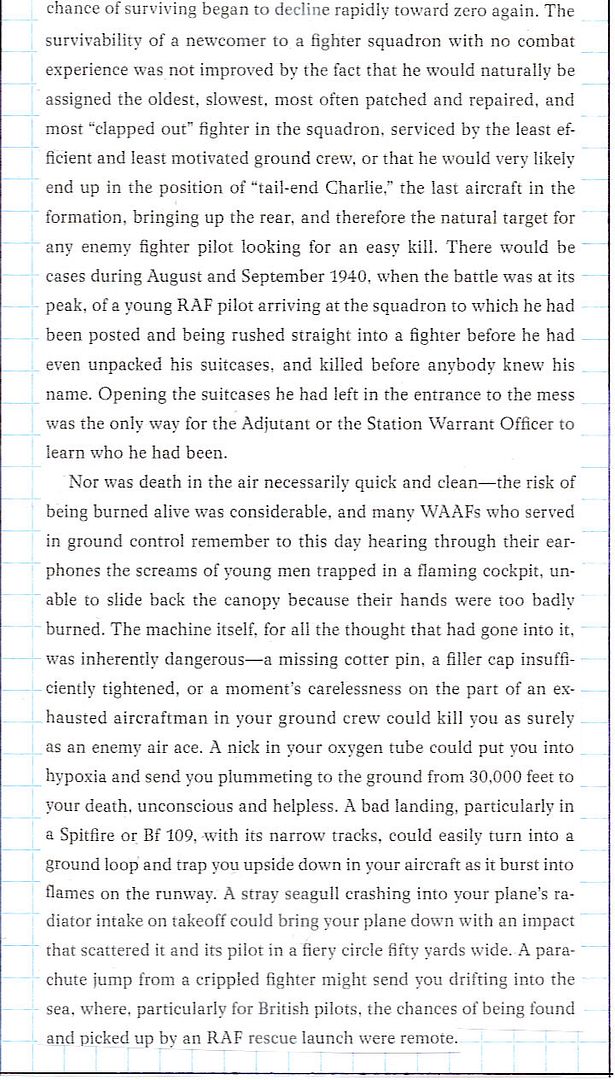
Michael Korda, With Wings Like Eagles: The Untold Story of the Battle of Britain
http://www.onwar.com/chrono/1940/sep40/f02sep40.htm
US gives surplus destroyers to Britain
Monday, September 2, 1940 www.onwar.com
In Washington... Following the agreement made in July and later detailed negotiations, a deal is now ratified between Britain and the USA by which Britain gets 50 old destroyers, veterans of World War I, but desperately needed for escort work, in return for bases granted to the United States in the West Indies and Bermuda. Considerable modification will be necessary to make the ships ready for service.
Over Britain... The German attacks on the British airfields continue.
In the Mediterranean... Admiral Cunningham’s fleet is reinforced by the battleship Valiant and the carrier Illustrious from Gibraltar. He now has three battleships and two carriers. The composition of the Gibraltar based Force H varies greatly from time to time because of the uncertainty regarding the behavior of the French Fleet. The Italians now have five battleships in commission, including two modern ships.
I'm surprised the Brits didn't attempt extermination of the entire German nation ~
http://homepage.ntlworld.com/andrew.etherington/month/thismonth/02.htm
September 2nd, 1939
UNITED KINGDOM: The British radar research centre at Bawdsey Manor, on the east coast, receives orders to disperse to scattered locations on the west coast. (Cris Wetton)
By 4.30 p.m. Poland has been at war for 36 hours, but no reply has been received in London from Berlin. In cabinet, Neville Chamberlain reads out a message from the French government: they want 48 hours more delay. At 6 p.m. Halifax calls Ciano and Parliament meets ‘in troubled silence’. At 7.30 p.m. a call is made from the Cabinet to Édouard Daladier the French Prime Minister, resulting in their agreement to restate Britain’s position to Germany without a time limit. At 7.44 p.m. Chamberlain relays this to the House of Commons, where it is received as half-hearted: Arthur Greenwood demands ‘no more devices’. A violent thunderstorm is raging over England, and a deputation from the House of Commons confronts Chamberlain demanding no further delay. ‘Right, gentlemen,’ the Prime Minister answers. ‘This means war.’ As he speaks a great clap of thunder shakes the building.
Lord Halifax calls Paris to establish a time limit; and at 10.30 p.m. Chamberlain’s peacetime Cabinet begins its final meeting. An absolute ultimatum will be sent to Germany.
Dr. Fritz Hesse, Press Councillor to the German Embassy in London, comes to Sir Horace Wilson, Chamberlain’s chief advisor, with an invitation from Ribbentrop for a secret meeting, ‘heart to heart’. Wilson refuses, but repeats that if Germany withdraws from Poland, bygones will be bygones.
The IRA launch a series of attacks on individual soldiers in the British Territorial Army.
Churchill, expecting at any minute to be invited to join the War Cabinet, has waited all day a message from Chamberlain. He sleeps with a pistol under his pillow and a guard on his door.
The last football matches are played. Some kick off late anticipating crowd and traffic problems.
On the last day of play Blackpool head the league. (72)
FRANCE:
Georges Bonnet, the French Foreign Minister contacts Ciano to try and arrange a symbolic German withdrawal. Ciano throws the message into the waste-paper basket before returning to bed.
Paris: Daladier addresses the Chamber of Deputies. (Gene Hanson)
The RAF sends ten squadrons of Fairey Battle light bombers to France.
GERMANY:
At 8.50 p.m. Ribbentrop informs Attolico that there will be no German withdrawal from Poland.
Germany announces that it will respect Norwegian neutrality.
POLAND: Rundstedt’s troops have crossed the River Warta, in Poland, in numerous places. The German Luftwaffe has wreaked havoc in the rear areas of the Polish armed forces. The far forward placement of most Polish regular forces has placed the swift moving German columns in their rear areas.
30 Polish towns and cities are bombed with more than 1500 casualties.
In the disputed Corridor, two Polish infantry divisions and the Pomorze cavalry brigade are cut off by the German XIX corps of the 4th Army and almost wiped out.
Polish submarine ORP Wilk is damaged by German depth charges. (Dave Shirlaw)
U.S.S.R.: Pravda features Hitler’s speech holding the Poles responsible for the war. (Mike Yared)
ITALY: 9.30 p.m. Sir Percy Loraine calls London from Rome to say that Mussolini is abandoning his efforts for peace.
GIBRALTAR: The first British convoy of the war leaves for Cape Town.
http://worldwar2daybyday.blogspot.com/
Day 368 September 2, 1940
Battle of Britain Day 55. Between 8 AM and 5.30 PM, 4 Luftwaffe raids fly up the Thames Estuary to bomb airfields in the Southeast of England. RAF is better able to cope using Air Vice Marshall Keith Park’s strategy to attack the massed bombers before they split up. Damage to airfields is consequently reduced; however, Detling & Hornchurch are still bombed and Eastchurch is put out of action indefinitely. Aircraft factories at Rochester and Weybridge are also bombed. RAF shoots down 27 German fighters and 10 bombers (antiaircraft guns account for 1 Bf109 and 3 more bombers). 20 RAF lose fighters with 10 pilots killed. Overnight, there is widespread bombing of towns in the Midlands, including Liverpool, Manchester and Sheffield, which promptly stops at 1.30 AM.
At 7 PM, U-47 sinks Belgian passenger and freight ship Ville de Mons (carrying 4378 tons of general cargo, 1280 boxes of pears, 648 tons of corn and 536 tons of wheat from new York) with 4 torpedoes 200 miles West of Isle of Lewis, Scotland. All 54 on board survive. At 10 PM, U-46 sinks British SS Thornlea 200 miles Northwest of Ireland (3 crew lost). 19 crew are picked up by Canadian destroyer HMCS Skeena. Another 14 survivors will be rescued next day by the Norwegian steamer Hild and landed at Sydney, Australia, on 15 September. http://www.uboat.net/allies/merchants/ships/510.html
U-58 departs base in the French port of Lorient, in the Bay of Biscay, and is attacked 30 miles out by British submarine HMS Tigris (all torpedoes miss U-58). At 8 PM, British submarine HMS Sturgeon sinks German SS Pionier off Skagen, Denmark. Pionier is carrying 750-1000 German troops, supplies and equipment from Frederikshavn, Denmark, to Frederiksstad, Norway (almost all are killed). http://translate.google.com/translate?hl=en&sl=da&u=http://www.nolimitsdiving.dk/NLD/Projekter/Pionier/Pionier_research.htm&ei=6vd-TMPyGIOB8gac2b3aAw&sa=X&oi=translate&ct=result&resnum=6&ved=0CCoQ7gEwBQ&prev=/search%3Fq%3DHMS%2BSturgeon%2BPionier%26hl%3Den%26rlz%3D1T4DKUS_enUS217US217
German armed merchant cruiser Widder sinks British tanker Cymbeline with the deck gun and a torpedo (7 crew killed) in the Central Atlantic 800 miles West of the Canary Islands. Wider spends 4 hours picking up 26 survivors. Cymbeline’s Captain, First Officer and Third Engineer escape in a lifeboat and will be rescued on September 16 by tanker Yolonda and taken to Venezuela.
The “Nazis Complete Tests for Invasion” article is interesting. Articles like this served German propaganda purposes for the build-up to the invasion of the USSR, not Britain. Surely the authors of the article could not have known that’s what they were doing.
Date: 2nd September 1940

Enemy action by day
The enemy's effort consisted mainly of five attacks in the East Kent - Thames Estuary area and during the course of those operations Fighter Squadrons destroyed 41 enemy aircraft (plus 18 probable and 32 damaged). Our casualties were 20 aircraft and 10 pilots killed or missing. Aerodromes appeared to be the targets.
North and East
Little activity took place. Four reconnaissance flights were made off the Norfolk Coast by single aircraft flying at about 10,000 feet between 1629 and 2055 hours.
South East
At 0750 and 0752 hours the Coast was crossed at Dover and Lympne by forty and thirty aircraft respectively at 20,000 feet while a small formation came in at Deal at 8,000 feet. The raids split inland and proceeded to Eastchurch, North Weald, Ochford and Biggin Hill. A further raid of thirty aircraft flying at 10,000 feet was intercepted near Hawkinge and turned back. Seven squadrons were detailed for this attack and inflicted casualties.
At 1220 hours two waves of 12+ and 30+ aircraft crossed the Coast at Folkestone and North Foreland and flew into the Estuary. Other raids penetrated to Maidstone. The battle was confined to East Kent from Rye to Shoeburyness. About one hundred aircraft were involved and dispersal to France took place at 1330 hour. Several enemy aircraft were shot down. Strong hostile formations continued to cruise in the Straits for about an hour.
At 1612 hours raids crossed the Coast at points North of Dungeness and Deal. One raid flew towards Biggin Hill and the remainder to the Thames Estuary and Essex flying over Hornchurch, North Weald and Colchester to Harwich. Some thirty enemy aircraft appeared to concentrate 10 miles South East of Central London where they turned back. In all some hundred aircraft took part. Four Fighter squadrons were in the air and successful interceptions were made.
Immediately after the above attackers had returned to France further raids amounting to seventy aircraft came in over Sheppey, Thames Estuary and East Kent at 1720 hours. This attack was of short duration and ended at 1750 hours.
At 1800 hours other raids totalling eighty enemy aircraft approached the Coast between North Foreland and Dungeness. They did not penetrate inland and after patrolling the Coast returned to France at 1830 hours. Strong patrols were maintained on the French side of the Channel.
West
At 1045 hours a single aircraft made a reconnaissance over South Wales and at 1400 hours one raid of two aircraft was plotted in the Bristol Channel.
By night
Enemy activity was extensive and was not so confined to specific areas as on recent nights. A feature was the early termination (0130 hours) of all the main attacks.
By dusk the enemy was operating along the East Coast, Wash to Tyne (mostly believed to be mine-laying), over Derby, in the Liverpool and in the Barrow-in-Furness areas. From 2200 to 0030 hours a steady stream of raids crossed the Coast between Beachy Head and Swanage and flew to the industrial Midlands as far as Liverpool, Manchester and Sheffield. Many enemy aircraft passed to and from these areas over London Central. Others flew in over the Wash. The number of raids towards South Wales was rather less than recently. Off North East Scotland there was increased activity and a number of raids were plotted between Rattray Head and as far north as Scapa. A convoy off Kinnairds Head called for help at 2240 hours.

________________________________________
Statistics
Fighter Command Serviceable Aircraft as at 0900 hours, 2nd September 1940
Casualties:
| Enemy Losses | ||
| By Fighters | ||
| Destroyed | Probable | Damaged |
| 19 Me109 | 8 Me109 | 11 Me109 |
| 8 Me110 | 5 Me110 | 8 Me110 |
| 2 He111 | 1 He111 | 2 He111 |
| 5 Do17 | 1 Do17 | 7 Do17 |
| 3 Do215 | 3 Do215 | 3 Do215 |
| 1 He113 | ||
| 37 | 18 | 32 |
| By Anti-Aircraft | ||
| Destroyed | Probable | Damaged |
| 1 Me109 | ||
| 3 Do17 | ||
| 4 |
Patrols:
Balloons:
Aerodromes:
Attacks on Aerodromes
Organisation:
Home Security Reports

Needless to say when Hitler came to power, the swastika fell out of fashion and was replaced by a yellow Thunderbird thus giving the unit its nickname.
There were no such thoughts that I've ever seen.
But "bombing them back to the stone ages" -- certainly.
"Unconditional surrender" -- absolutely.
The main idea was that, unlike the First World War, German people must this time be thoroughly defeated, no ifs ands or buts about it.
They must come to understand in their hearts of hearts that wars of naked conquest cannot pay.
So the allies' harshness against German civilians was not only a matter of restricting wartime production, but also an effort to demoralize them.
Of course, it didn't work in Germany -- any more than German bombing demoralized Britain -- during the war.
But memories of the destruction have helped keep Europeans remarkably peaceful ever since... ;-)
Disclaimer: Opinions posted on Free Republic are those of the individual posters and do not necessarily represent the opinion of Free Republic or its management. All materials posted herein are protected by copyright law and the exemption for fair use of copyrighted works.